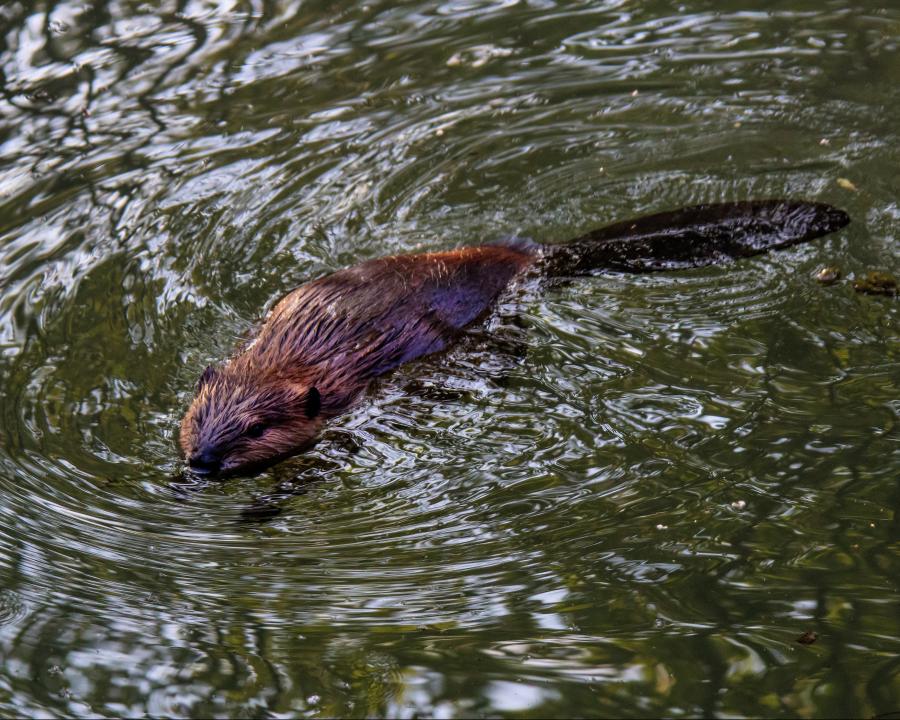By Rick Claybrook, Wildlife Biologist
Beavers have special talents and a never-ending will to dam flowing water. This insatiable desire has tormented the human race for centuries. For the most part, beavers have only done what comes natural to them. It’s man’s desire and actions that has resulted in the ongoing struggle and conflicts between man and beaver.
Granted, beaver activities can interfere with man’s efforts to manage land. For instance, a planted forest or agriculture crop flooded by a newly constructed beaver dam; a manmade pond damaged by beavers undermining the earthen dam; a flooded road resulting from a culvert plugged by beavers, or trees girdled and cut down by beavers for food or materials to repair dam site and home. However, these actions simply result from what a beaver must do to survive.
In the beaver’s defense, its actions are generally beneficial to the environment. Actually, the beaver can be termed a keystone species. Impoundments created by beavers damming a stream evolve into valuable wetlands that provide habitats that support a complex biodiversity of plant and animal life. In addition, the dam site and created wetland trap sediments, excess nutrients, and pollutants (toxic pesticides and other toxins). These are broken down and decomposed through metabolic processes, resulting in much cleaner water flowing downstream. Beaver ponds also minimize runoff from heavy rainfall easing downstream flooding and soil erosion. Not only does the dam site complex slow the forces of water during periods of heavy rainfall, it also retains a reservoir of water that helps maintain a constant downstream flow during periods of drought.
Beaver ponds increase wildlife carrying capacity by providing a valuable water source during long periods of drought. Rich, moist soils associated with these sites produce an abundance of lush nutritious plant species, which are consumed as food or used for cover by many different wildlife species. There is certainly no dispute the wetlands created by beavers result into a valuable life sustaining ecosystem complex from which our environment greatly benefits.
The beaver is a semi-aquatic mammal and North America’s largest rodent reaching a length of over 3 feet and a weight in excess of 40 pounds. Large ever-growing orange upper and lower front teeth characterize the beaver as a rodent and allow it to cut down trees and other plants. Beavers eat tender plants and the soft layer of cellular tissue between the bark and wood. Other parts of felled trees are carried by mouth to the dam or lodge construction sites.
The beaver is perfectly designed and adapted for its watery habitat. Its body is symmetrically shaped for easy movement through water. The large webbed hind feet aid with swimming while its flat scaly tail acts as a rudder. The beaver uses its dexterous front feet, not its tail, to move and pack mud and stones.
The beaver’s dark fur repels water while the fine under-fur traps air to help maintain body heat. The transparent nictitating eyelids protect the eyes and aid the beaver to see its surroundings underwater. Special valves in the nostrils and ears automatically seal shut to keep water out when swimming. The beaver’s lips are lined with fur and can close behind the front teeth to prevent water and other unwanted materials from entering the trachea. These are some of the physical adaptations that allow the beaver to feel right at home under water. A beaver can stay active under water for up to 15 minutes.
Beavers are active year-round and mostly at night. They reach sexual maturity at approximately two years of age. A litter of one to four kits is born in the spring and stay under the parents’ care for two years before setting out on their own. Beavers live in small family groups consisting of the breeding pair, newborn kits, and young born the previous year, which earn their keep by helping maintain the dam site and caring for newborns.
Learning to live with beavers is usually the best way to retain peace of mind and reconcile human and beaver conflicts. Removing beavers entirely from an area is very difficult and, if accomplished, it is a good bet that the unoccupied wetland will be inhabited by other beavers living up or down stream from the site. The total removal of beavers can result in the loss of very beneficial wildlife habitat.
Flooded property or roads may be easily corrected by the installation of a cost effective beaver flooding control device. If it is impossible for you to “leave it to beaver,” call your nearest Alabama Division of Wildlife and Freshwater Fisheries district office for help.






